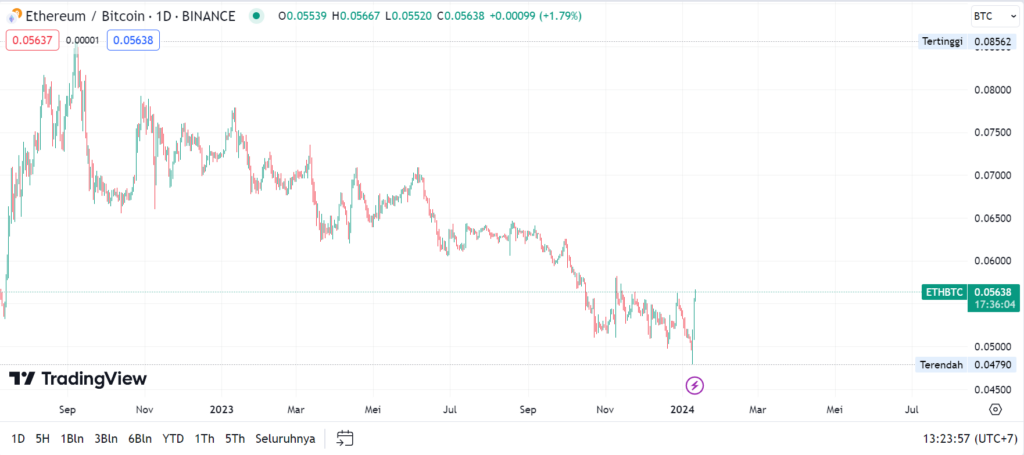Ethereum Beats Bitcoin's Performance, Spot ETH ETF Speculation?

Ethereum Touches $2,600
Ethereum (ETH) showed a price gain of +11.2% and briefly broke through the price of US$2,638 on January 11, 2024 at 06:00 WIB. This level was last seen in May 2022.
This price increase can be said to be quite significant because ETH has been sideways in the area of US$2,100-US$2,300 for a month since December 2023.
The price of ETH against BTC (ETH/BTC) has been in a bearish trend since September 2022, and bottomed out at 0.0479. But thanks to this price increase, ETH gained about +16% against BTC. Figure: ETH/BTC price chart.
Figure: ETH/BTC price chart.
Interestingly, this ETH price increase occurred just as the spot Bitcoin ETF was approved (11/1/24). Intuitively, this illustrates the majority of the crypto community wanting to know whether a spot ETF product for crypto will be approved or not.
If so, as has already happened that the spot Bitcoin ETF is approved, then there is great potential if ETF products for other crypto assets are also approved. In this case, ETH as the second largest crypto asset by valuation, has a great opportunity to become the next spot ETF product.
Given this speculation, it is likely that investors who have accumulated Bitcoin, withdrawn profits and turned their capital into ETH anticipate the possibility of a spot Ethereum ETF before the mainstream.
Based on data from Lookonchain, it was observed that after the approval of the Bitcoin ETF, there was a wallet that utilized the Aave lending platform by borrowing 621 wrapped BTC (WBTC) worth US $ 28.95 million and exchanged for 11,663 ETH.
After the spot #Bitcoin ETF was approved, this whale continued to borrow $WBTC and exchange it for $ETH.
This whale borrowed a total of 621 $WBTC($28.95M) and exchanged it for 11,663 $ETH at a rate of 0.05327.
The whale is long the ETH/BTC trading pair! https://t.co/4uE6Lhgjzx pic.twitter.com/4x93OmYRHL
— Lookonchain (@lookonchain) January 11, 2024
This shows that the wallet owners are more optimistic about the performance of ETH than BTC after the spot Bitcoin ETF is legalized.
Vitalik Buterin Wants to Increase Ethereum's Gas Limit

Buterin noted that the gas limit has not been raised for nearly three years, which is the longest time in the protocol's history.
"To be honest, I think it's normal to increase the gas fee limit even now," Buterin said.
Ethereum's gas limit refers to the maximum amount of gas spent executing transactions or smart contracts in each block. Gas is a fee required to make a transaction or execute a contract on the blockchain.
Gas limits are set to ensure that blocks are not too large, which will have an impact on network performance and synchronization. Validators can also dynamically adjust gas limits within certain parameters as they generate blocks.
By increasing the gas limit, the theory is that it will allow more transactions within each block, which theoretically increases the overall throughput and capacity of the network. However, these improvements also have the potential to increase the load on hardware and the risk of spam and network attacks.
Reap Ethereum Developer Protests
On the other hand, Ethereum developer Marius van der Wijden expressed major concerns if the gas limit is raised, especially related to the growth of the blockchain's state size.
On his Github account, Wijden explained that the blockchain's state size is around 267GB, and it will grow faster if the gas limit is increased. The full historical data size of the Ethereum blockchain is currently around 900GB.
Gnosis co-founder Martin Köppelmann also expressed concern, stating there would be an increase in bandwidth if the gas limit was raised. Another Ethereum team, Péter Szilágyi also voiced similar concerns.
"Improving it must have a downside. State will grow faster, synchronization times will become slower, DoS potential will grow," he said.
Wijden suggested that before considering increasing the gas limit, it is necessary to wait for the impact of EIP-4844 on the mainnet.
EIP-4844 aims to improve storage and I/O node efficiency by moving availability data from Layer 2 transactions to 'blobs' that expire after a few weeks. This will reduce the growth of the blockchain's historical size and slow down the growth of state size.












































